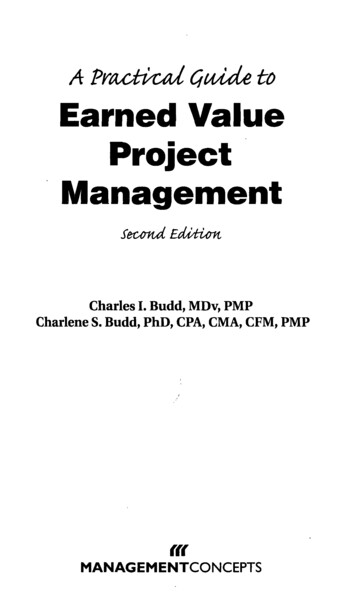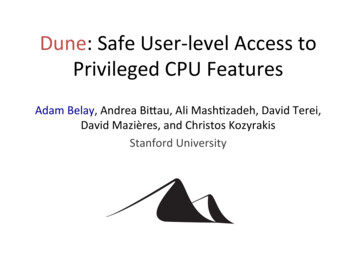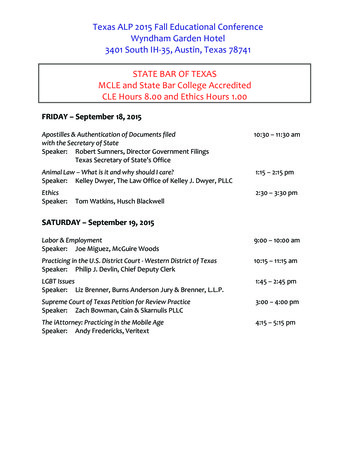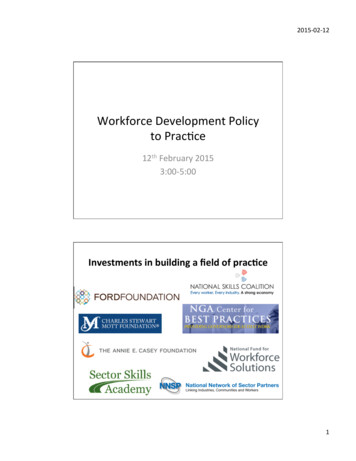
Transcription
A Pr&ctvaU Quide toEarned ValueProjectManagementSecond EcUtvonCharles I. Budd, MDv, PMPCharlene S. Budd, PhD, CPA, CMA, CFM, PMPMANAGEMENTCONCEPTS
* W v jfj : . V-.-.- '--. :jifei'V.-: 1 . . : - " ContentsPreface to the Second EditionPART I: Introductionxix1CHAPTER 1: Background and MotivationOur Basic PremiseThe Three Basic Parameters of Project ManagementBusiness ChangesThe Need for a Cost and Schedule Control SystemProject Management MaturityLooking for Value in All the Wrong PlacesOur Example ProjectDiscussion Questions34456891011CHAPTER2: Project ManagementAProjectThe Project CharterProject Life CyclesThe Basic ApproachAMore Comprehensive ApproachMinimum Life Cycle Requirements13141518192023
A PRACTICAL GUIDE TO EARNED VALUE PROJECT MANAGEMENTEVMS ProjectsThe Project Management OfficeEvolving Project Management MaturityThe Project ManagerA Personal Observation of AuthorityThe Project TeamDiscussion Questions23252729303032PART II: The Basics of Earned Value35CHAPTER3: Earned Value MetricsPrimary MetricsTotal Value (TV) or Budget at Completion (BAC)Planned Value (PV) or Budgeted Cost of WorkScheduled (BCWS)Earned Value or Budgeted Cost of WorkPerformed (BCWP)Actual Cost (AC) or Actual Cost of WorkPerformed (ACWP)Reporting and Comparison MetricsAnalogy to the Standard Cost SystemCalculation of RatiosForecasting MetricsCalculations ExampleUsing the MeasurementsThe Challenge of Meeting All TargetsInformation and MotivationDiscussion Questions and Practice CalculationsQuestionsPractice Calculations373738393940404243454547515151CHAPTER 4: The Earned Value Management SystemEvolution of the Earned Value Management SystemConcepts of Earned Value ManagementEarned Value DennedCriteria and Metrics53535455563839
CONTENTSxiRequiring the Use of EVMSDriving Force for Using EVMSWhy All the Interest in EVMS?Supportfor the Value of EVMSDiscussion of the EvidenceThe DarkSideSome Missing InformationDollars, Time, and the ScheduleDysfunctional BehaviorA High-Level View of the 32 EVMS CriteriaOrganizationPlanning and BudgetingAccounting ConsiderationsAnalysis and Management ReportsRevisions and Data MaintenanceDiscussion Questions57585960616565676868696969707071PARTIII: It's All in the Plan73CHAPTER 5: The Project Plan (Criterion 1)EVMS Criterion 1The Work Breakdown StructureWBS Definitions and StandardsTwo Possible WBS StructuresSteps in Constructing a WBSDenning the ProjectThe Mechanics of aWBSWBS ChartsWBS LevelsAWBS DictionaryControl AccountsWorkPackagesDiscussion Questions7575767778798183848687889094
xiiA PRACTICAL GUIDE TO EARNED VALUE PROJECT MANAGEMENTCHAPTER 6: The Organization (Criteria 2-5)Organizational ConfigurationsFunctional StyleMatrixStyleProject-Oriented StyleEVMS Criterion2Organizational Breakdown StructureProject StaffingOBS LimitationsEVMS Criterion 3Linear Responsibility ChartControl Account PlanEVMS Criterion4EVMS Criterion 5Discussion PTER 7: The Schedule (Criteria 6-8)Schedule UncertaintyChallenges in Constructing a Realistic ScheduleOvercoming Schedule ProblemsA Bit of Statistics and ProbabilityEVMS Criterion 6Sequence of WorkTask DependenciesSchedule Representation and EvaluationListsBar ChartsNetworksCritical Path MethodEVMS Criterion 7EVMS Criterion 8The Target BaselineSummary-Level Planning PackagesControls and ReportingOver-Target BaselineDiscussion 1132133134135135137
CONTENTSCHAPTER 8: The Budget (Criteria 9-15)EVMS Criterion 9EVMS Criterion 10Work Packages and Planning PackagesSpecial PackagesEVMS Criterion 11EVMSCriterion 12EVMS Criterion 13EVMS Criterion 14EVMS Criterion 15Project Cost EstimationCostDataProject ControlsEstimating MethodsDiscussion 53157PART IV: Project Status159CHAPTER 9: Tracking Performance (Criteria 16-21)EVMS AccountingEVMS Criterion 16Direct CostsSpecial CircumstancesEVMS Criterion 17EVMSCriterion 18,EVMS Criterion 19:".CostPoolsCost Pool DriversCost Allocation MethodsDirect Allocation MethodStep-Down Allocation MethodReciprocal Allocation MethodActivity-Based Costing MethodEVMS Criterion 20EVMS Criterion 21Accounting and Earned Value SoftwareDiscussion 3174176178180181
xivA PRACTICAL GUIDE TO EARNED VALUE PROJECT MANAGEMENTAppendix 9-A. Reciprocal Allocation ofOverhead Costs183CHAPTER 10: Reporting Variances (Criteria 22-27)EVMS Criterion 22EVMS Criterion 23Schedule VarianceCost VarianceExplaining VariancesEVMS Criterion 24EVMSCriterion25EVMS Criterion 26EVMSCriterion27Performance to DateInterpreting the VariancesTechnical PerformanceUpdated Values for MaterialsEstimates of Future ConditionsPerformance ReportingPractice CalculationsExercise 1Exercise 09209210PART V: Handling a Project's Changes and Termination211CHAPTER 11: Time for a Change (Criteria 28-32)Uncertainty May Be the Only CertaintyUnderstanding the Elements of RiskRisk ManagementRisk AssessmentRisk DispositionRisk MonitoringContinuous Risk ManagementRisk Management ToolsWhen Change Becomes NecessaryEVMS Criterion 28Authorized ChangesDirected Effort213213215216217222223224225226227228231
CONTENTSEVMS Criterion 29EVMS Criterion 30EVMS Criterion 31EVMS Criterion 32Discussion Questions232232233233235CHAPTER 12: Are We There Yet?Project TerminationCompletingthe ProjectPost-Project ActivitiesDiscussion Questions237238239244248PART VI: Earned Value Implementations251CHAPTER 13: Implementing EVMSReasons to Implement EVMSThe Implementation PlanDetails of ImplementationOrganizational SupportEducation and TrainingEliciting Desired BehaviorDo Your Own Thing, ButCarefullySoftware AssistanceImplementation CostDiscussion Questions253254255255256257258261262263265CHAPTER 14: Government ContractsInformation SourcesDoD WebsitesFederal Acquisition Regulation SystemDoD Reference MaterialCouncils and AgenciesCompliance, Validation, and SurveillanceInitial Compliance ReviewIntegrated Baseline APTER 15: Partial EV ImplementationsEarnedValue for Project Control287288
xviA PRACTICAL GUIDE TO EARNED VALUE PROJECT MANAGEMENTAbridged EV ImplementationsFirst Alternative: An Informal EVMS Implementation.Second Alternative: High-Level Control AccountsThird Alternative: Follow Basic EVMS PrinciplesFourth Alternative: The Very Least EVImplementationDiscussion Questions289289290291PART VII: Emerging PracticesPerformance-Based Earned ValueSchedule MarginEmerging Practices to Be Treated in Greater Detail299299300301CHAPTER 16: Earned ScheduleRationale for the Development of Earned ScheduleEarned Schedule ConceptsCalculating Earned ScheduleDefinitions:Example of Earned Schedule ComputationsOther Earned Schedule MetricsTime-Based Metrics For ForecastingPerformance Factor (Time)Reconciling Schedule Variance in Time withSchedule Variance in DollarsValidation of Usefulness of Earned SchedulePractice Calculations and Discussion Questions303304305306307307314314315CHAPTER 17: Critical Chain Project ManagementBackgroundDevelopment of Critical ChainTraditional Project Management ProblemsThe Critical Chain SolutionA Single Project EnvironmentTraditional SchedulingA Simulated Result from Traditional SchedulingCritical Chain SchedulingCritical Chain ResultsUsing Buffer Management To Control 319320
CONTENTSMultiproject EnvironmentsUse of Critical Chain with EVMSCritical Chain in Lower Levels of the PerformanceMeasurement BaselineTwo Project PlansPractice Calculations341342343344346APPENDIXA: The 32 EVMS CriteriaOrganizationPlanning and BudgetingAccounting ConsiderationsAnalysis and Management ReportsRevisions and Data Maintenance349349350351352353APPENDIX B: Discussion Responsesand Exercise Solutions355Glossary363Bibliography383Index393
EVMS Projects 23 The Project Management Office 25 Evolving Project Management Maturity 27 The Project Manager 29 A Personal Observation of Authority 30 The Project Team 30 Discussion Questions 32 PART II: The Basics of Earned Value 35 CHAPTER3: Earned Value Metrics 37 Primary Metrics 37 Total Value (TV) or Budget at Completion (BAC) 38 Planned Value (PV) or Budgeted Cost of Work Scheduled .










